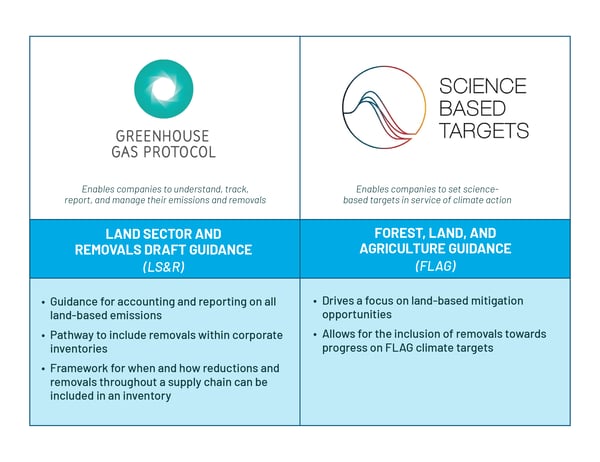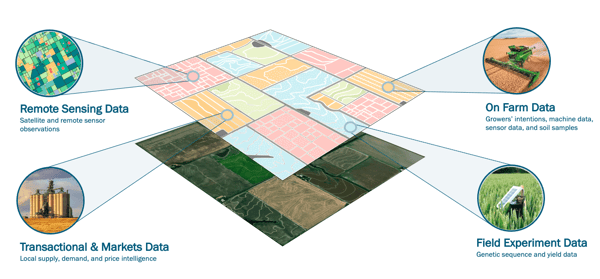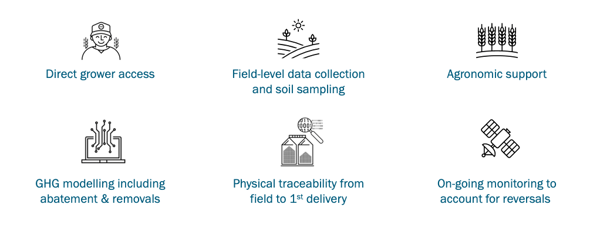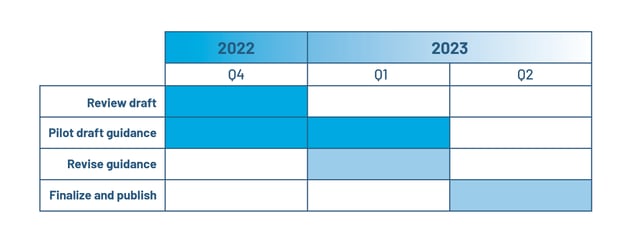Is the World Finally Ready to Tackle Scope 3 Emissions in Agriculture?
Additional writing and reporting by Ryan Daly
As a company buying agricultural products such as grains and fibers, you may be looking to account for greenhouse gas reductions and removals in your supply chain—but are you prepared to accurately measure these changes? Until now, there has been minimal guidance for calculating comprehensive GHG inventories and tracking progress over time. Without a roadmap for how to hit a target, decarbonizing a land-based supply chain has been difficult to impossible to accomplish.
In late September, the release of two long-anticipated guidance documents started to clear up the ambiguities. These documents came from the Greenhouse Gas Protocol (GHGP) and Science Based Targets initiative (SBTi), two independent, multi-stakeholder organizations which develop guidance on corporate accounting and target setting respectively:
- GHGP released the Land Sector and Removals (LS&R) draft guidance, which provides direction on inventory accounting for land-based activities and removals, and
- SBTi released the Forest, Land, and Agriculture (FLAG) final guidance, which provides a framework for setting and achieving science-based targets in the FLAG sector.
 What You Need to Know: GHGP LS&R
What You Need to Know: GHGP LS&R
This guidance builds off GHGP’s earlier documents, providing a framework for organizations with land sector activities in their value chains to:
- Account for and report on all their land-based emissions
Previously, a lack of guidance meant that land-related emissions were inconsistently considered or even excluded from inventories. But now with the draft LS&R guidance, companies can account for land-related emissions comprehensively. This includes land use change (e.g., deforestation), land management emissions (e.g., tillage and fertilizer usage), and land tracking metrics (e.g., land occupation).
- Include greenhouse gas removals within their corporate inventories
Companies need to invest in both emission reductions and atmospheric carbon removals to limit further warming and climate disruptions. This guidance offers a historic shift: For the first time, companies now have a pathway to account for removals within their inventories.
This pathway comes with many caveats. Companies must use primary data, quantify uncertainty, demonstrate traceability to the farm or field level, monitor changes on an ongoing basis, and account for reversals. These safeguards are in place to ensure the principles of accuracy, conservativeness, and permanence are met. The need for a high bar of scientific rigor is one that Indigo has focused on and actively championed for years.1
- Account for reductions and removals originating throughout their supply chain
As companies move beyond setting baselines, they have grappled with a complicated question: How and when can we take credit for interventions in our value chain? The LS&R draft guidance provides clarity here. Claiming a project’s outcome does not require additionality or causality, but traceability. Insets, which generally can be defined as offsets that are within a company’s value chain, can be used as claim mechanisms within this context, but outcomes must be quantified using inventory accounting.
What You Need to Know: SBTi FLAG
On the SBTi side, land-intensive companies are now required to set FLAG targets in addition to energy or industry targets. The SBTi FLAG guidance accomplishes some major outcomes:
- Drives a focus on land-based mitigation opportunities
Only land-based mitigation can count as progress towards FLAG targets. In order to meet FLAG targets, companies now have a stronger impetus to invest in solutions such as farming practices that bolster soil health, reduce the need for chemical and synthetic inputs, and improve overall farm economics.
- Allows for—and, in fact, expects—the inclusion of removals towards progress against FLAG targets
The FLAG guidance recognizes that both emissions and removals are needed from the land sector to align with 1.5° Celsius pathways, highlighting that removals account for around 50% of the global land-related mitigation opportunity. Accordingly, companies that set FLAG-sector science-based targets are expected to achieve more than a third of their progress towards targets via removals.
The overall effect of the collective GHGP and SBTi guidance is that several roadblocks that had previously hindered corporate action in land-intensive supply chains may finally be swept away, leading to new opportunities for farmers and companies alike. The inclusion of removals in inventories opens the door for partnerships that incentivize better on-farm performance. And the emphasis on traceability, rather than additionality, means those already implementing more sustainable practices can still be rewarded.
Where We Can Help: Indigo’s Capabilities
Indigo Ag has worked with companies for years to deliver continuous improvement on emission reductions within their supply chains and to quantify those impacts for their reporting. Working first to understand a company's supply area, then working with farmers in that area to verify and scale the use of sustainable practices, we have delivered emission reductions tied to physical commodities while paying millions of dollars to rice, cotton, and wheat farmers.
Using our technology to verify sustainable practice adoption on cotton farms, The North Face, Timberland, and Vans have sustainably sourced 7.7 million quality garments. All the while, Indigo delivers the technological infrastructure to track the contracts for these bushels of grain and pounds of fiber from farmer to agribusiness. We combine data from multiple sources, ranging from on farm data, to remote sensing, to field experiment data, to track and quantify sustainable practices field-by-field
We combine data from multiple sources, ranging from on farm data, to remote sensing, to field experiment data, to track and quantify sustainable practices field-by-field
Operating with scientific rigor across geographies, crops, and agronomic practices is possible thanks to our sophisticated planning, measurement, reporting, and verification capabilities—which we refer to as our planning and MRV engine. Companies are already familiar with MRV, a term for quantifying, confirming, and sharing an exact climate impact. We also developed planning capabilities in our engine because the transition to sustainable practices is a multi-year, complex process for a farming operation—and farmers should be supported every step of the way.
Beyond helping companies to reduce their emission targets tied to physical commodities, Indigo has also led the development of the carbon removals market in agriculture. This past June, we were the first to produce a crop of verified, registry-issued ag carbon credits at scale, issuing around 20,000 credits that complied with the strictest standards on permanence, leakage, monitoring, modeling, additionality, uncertainty quantification, and verification. To date, we have enrolled over 5.5 million acres in our carbon credit program. Through our Market+ Source and Carbon by Indigo programs, we have built unique capabilities which provide the building blocks for delivering GHGP-aligned scope 3 intervention programs
Through our Market+ Source and Carbon by Indigo programs, we have built unique capabilities which provide the building blocks for delivering GHGP-aligned scope 3 intervention programs
How Will the Draft Guidance Evolve from Here?
We now have SBTi which requires land-intensive companies to set FLAG targets built on land-based emissions and removals, as well as the GHGP which tells them how to account for those emissions and removals. But how will this work in practice for companies? The LS&R draft guidance introduces several requirements that will make a company’s ability to incorporate removals and project-based reductions into their accounting complicated and difficult. Chief among these challenges is:
- Traceability, since under the draft guidance, companies must demonstrate physical traceability to be able to capture a project’s benefits, and
- Monitoring in perpetuity, since this accounting requires companies to monitor claimed removals forever, and to take ownership of reversals whenever they might occur
Without accurate and extensive insight into on-farm activities and the agricultural supply chain, these two barriers can be intimidating. Physical traceability requires significant time and resources. Monitoring in perpetuity places the risk of reversal burden on companies themselves, in contrast to how permanence is handled through many offset crediting programs, where the registry and project developer are responsible for making reversals whole. With Indigo’s expertise in the application of greenhouse gas removals and reductions towards a specific climate goal, as well as our deep knowledge of the farmer’s financial and agronomic opportunities and limitations, Indigo is in a unique position to provide feedback on these protocols during the two-month commentary period. We will provide detailed recommendations as part of the review group to benefit both the users of this guidance and the farmers who are ultimately responsible for managing the land.
With Indigo’s expertise in the application of greenhouse gas removals and reductions towards a specific climate goal, as well as our deep knowledge of the farmer’s financial and agronomic opportunities and limitations, Indigo is in a unique position to provide feedback on these protocols during the two-month commentary period. We will provide detailed recommendations as part of the review group to benefit both the users of this guidance and the farmers who are ultimately responsible for managing the land.
Where Should a Company Interested in Scope 3 Go Next?
Creating a standard for quantifying land-use emission changes is not a small task. Just the opposite is true: Since land has such biological, geological, and chemical complexity – in addition to the complexity of the farming operations that manage the land – it is an enormous challenge to create a rigorous framework for food, beverage, apparel, and other companies to track their emissions.
But this kind of scientific and business complexity is Indigo’s specialty. We have the scientific and technological capabilities and deep agriculture industry relationships to support companies as they implement the GHGP and SBTi FLAG guidance in their own reporting. We look forward to showing you how.
Learn more about Source by Indigo to drive impact in your ag supply chain.
Read more about Scope 3 emissions in our related blog post.


